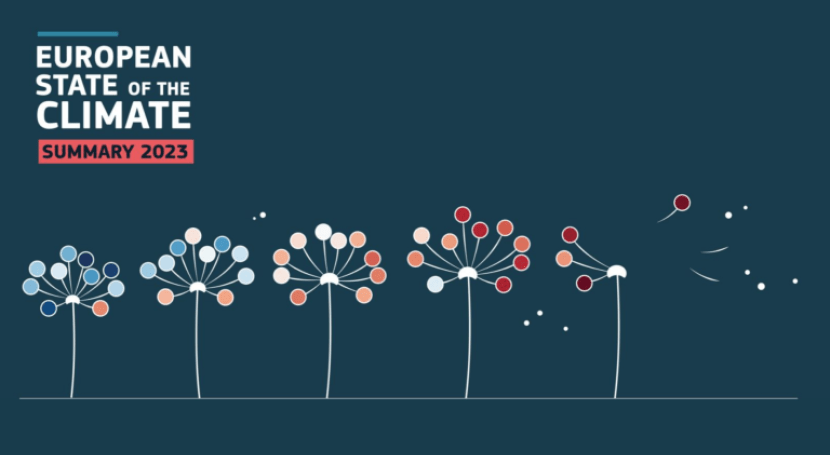In 2023, the impacts of climate change continued to be seen across Europe, with millions of people impacted by extreme weather events, making the development of mitigation and adaptation measurements a priority. To achieve this, understanding climate trends is vital. The Copernicus Climate Change Service (C3S), together with the World Meteorological Organization (WMO), released the 2023 European State of the Climate report (ESOTC 2023).
Key messages
- 2023 was the joint warmest or second warmest year on record depending on the dataset
- Average sea surface temperature for the ocean across Europe was highest on record
- Adverse health impacts related to extreme weather and climate events is rising
- Alps saw exceptional glacier ice loss
- Record proportion of actual electricity generation by renewables in Europe, at 43%.
The report provides descriptions and analysis of climate conditions and variations from across the Earth system, key events and their impacts, and a discussion of climate policy and action with a focus on human health. The ESOTC also includes updates on the long-term evolution of key Climate Indicators.
Key findings regarding temperatures in Europe:
- 2023 was the joint warmest or second warmest year on record depending on the dataset.
- Temperatures in Europe were above average for 11 months of the year, including the warmest September on record.
- 2023 saw a record number of days with ‘extreme heat stress’. There is an increasing trend in the number of days with at least ‘strong heat stress’ across Europe.
- Heat-related mortality has increased by around 30% in the past 20 years and heat-related deaths are estimated to have increased in 94% of the European regions monitored.
Key findings – European climate policy and action for health:
- The number of adverse health impacts related to extreme weather and climate events is rising.
- Evidence from the last decade shows generally good awareness but a low-risk perception of heat by the public, vulnerable groups and some health care providers.
- Initiatives such as the WMO Regional Climate Centre’s Climate Watch System, and other early warning systems, raise awareness of predicted extreme events to enhance societal preparedness.
- Health risk and adaptation differ between countries.
- Tailored climate services for the health sector are effective in increasing resilience, with significant potential for further development.
- Health adaptation can build on established health system infrastructures, but progress has been limited.
Key findings for the European ocean:
- For the year as a whole, the average sea surface temperature for the ocean across Europe was the highest on record.
- In June, the Atlantic Ocean west of Ireland and around the United Kingdom was impacted by a marine heatwave that was classified as ‘extreme’ and in some areas ‘beyond extreme’, with sea surface temperatures as much as 5°C above average.
Key findings regarding hydrological variables in Europe:
- During 2023, Europe as a whole saw around 7% more precipitation than average.
- Averaged across the European river network, river flows were the highest on record for December, with ‘exceptionally high’ flow in almost a quarter of the river network.
- During 2023, one third of the European river network saw river flows exceeding the ‘high’ flood threshold, and 16% exceeding the ‘severe’ flood threshold.
Key findings – renewable energy resources:
- The year saw a record proportion of actual electricity generation by renewables in Europe, at 43%.
- Increased storm activity through October to December resulted in above-average potential for wind power production.
- Potential for run-of-river hydropower generation was above average across much of Europe for the year as a whole, linked to above-average precipitation and river flow.
- For the year as a whole, potential for solar photovoltaic power generation was below average in northwestern and central Europe, and above average in southwestern and southern Europe, and Fennoscandia.
Key findings for snow and glaciers in Europe:
- Much of Europe experienced fewer days with snow than average, particularly across central Europe and the Alps during winter and spring.
- The Alps saw exceptional glacier ice loss in 2023, linked to below-average winter snow accumulation and strong summer melt due to heatwaves.
- Over 2022 and 2023, glaciers in the Alps have lost around 10% of their remaining volume.
Key findings – Arctic region:
- The year was the sixth warmest on record for the Arctic as a whole. For Arctic land, it was the fifth warmest, closely behind 2022. The five warmest years on record for Arctic land have all occurred since 2016.
- Arctic Sea ice extent remained below average through most of 2023. At its annual maximum in March, the monthly extent was 4% below average, ranking fifth lowest on record. At its annual minimum in September, the monthly extent ranked sixth lowest, at 18% below average.
- Total wildfire carbon emissions from the sub-Arctic and Arctic regions were the second highest on record. Most high-latitude wildfires occurred in Canada between May and September.
Carlo Buontempo, C3S Director, comments: “In 2023, Europe witnessed the largest wildfire ever recorded, one of the wettest years, severe marine heatwaves and widespread devastating flooding. Temperatures continue to increase, making our data ever more vital in preparing for the impacts of climate change.”
European climate in a warming world
Europe is no exception when it comes to the consequences of climate change. It is the fastest warming continent, with temperatures rising at around twice the global average rate. The three warmest years on record for Europe have all occurred since 2020, and the ten warmest since 2007.

Annual surface air temperature anomalies over European (as defined by the WMO Regional Association VI) land, from a range of datasets, for 1900 to 2023 (start year varies by dataset), relative to the average for the 1991–2020 reference period. Data source: HadCRUT5, NOAAGlobalTemp, GISTEMP, Berkeley Earth, JRA-55, ERA5.
WMO
For the year as a whole, the average sea-surface temperature (SST) for the ocean across Europe was the warmest on record. Parts of the Mediterranean Sea and the northeastern Atlantic Ocean saw their highest annual average SST on record.

Ranking of the annual average sea surface temperatures in 2023, relative to the 44-year period from 1980 to 2023. Darker shades indicate the highest and lowest rankings; the darkest red shows the areas where 2023 was the warmest year on record. Lighter shades indicate areas that were closer to average. Data source: ESA SST CCI Analysis v3.0. Credit: ESACCI/EOCIS/UKMCAS and C3S/ECMWF.
Impacts of climate change on the health of people in Europe
The ESOTC report underscores the profound impact of heat stress on public health. Heat stress is a measure of how the human body responds to the impact of high temperatures combined with other factors such as humidity and wind speed, amongst others. Prolonged exposure to heat stress can exacerbate existing health conditions and increase the risk of heat-related illnesses such as heat exhaustion and heatstroke, particularly among vulnerable populations.
In the last 20 years, heat-related mortality has increased by around 30%, and heat-related deaths are estimated to have increased in 94% of European regions monitored. This trend is particularly concerning, given that Europe is seeing an increasing number of days with at least ‘strong heat stress’, and in 2023 experienced a record number of days with ‘extreme heat stress’.

Number of days that experienced ‘very strong heat stress’ (UTCI between 38 and 46°C) during June, July, August and September 2023. Data source: ERA5-HEAT. Credit: C3S/ECMWF
In addition to the challenges that heatwaves present to health, there are other extreme weather events that severely impacted people in Europe in 2023. According to preliminary estimates for 2023 from the International Disaster Database (EM-DAT), last year in Europe, 63 lives were unfortunately lost due to storms, 44 to floods and 44 to wildfires. Weather- and climate-related economic losses in 2023 are estimated at more than €13.4 billion.
Celeste Saulo, Secretary-General, World Meteorological Organization (WMO) comments: “The climate crisis is the biggest challenge of our generation. The cost of climate action may seem high, but the cost of inaction is much higher. As this report shows, we need to leverage science to provide solutions for the good of society.”
Summer in Europe in 2023 – a season of contrasts
Summer 2023 was not the warmest on record, but saw conditions that were, at times, extreme. There were contrasts in temperature and precipitation across the continent and from one month to the next. The ‘extended summer’ (June to September) saw heatwaves, wildfires, droughts and flooding.
Northwestern Europe saw its warmest June on record, while Mediterranean areas saw well-above-average precipitation for the month. In July, this pattern was almost reversed. In August, southern Europe saw warmer-than-average temperatures, and September was the warmest on record for Europe as a whole. Much of Europe was impacted by heatwaves during the extended summer, and both August and September also saw severe flood events. At the peak of a heatwave in July, 41% of southern Europe was affected by at least ‘strong heat stress’, with potential for health impacts.
Widespread flooding across Europe
During 2023, one third of the European river network saw river flows exceeding the ‘high’ flood threshold, and 16% exceeding the 'severe' flood threshold. Record or near-record high river flows were seen in major river basins, including the Loire, Rhine and Danube, due to a series of storms between October and December. According to preliminary estimates from the International Disaster Database (EM-DAT), flooding in 2023 affected an estimated 1.6 million people in Europe and caused around 81% of the year’s economic losses due to climate impacts on the continent.
European climate and the potential for renewable energy
Monitoring of wind, solar radiation and hydrological variables is crucial for effective climate policy implementation in Europe, as it provides essential data for optimising renewable energy generation and mitigating carbon emissions. By understanding regional variations in these renewable resources, policymakers can develop targeted strategies to accelerate the transition to sustainable energy sources, fostering both environmental protection and economic growth.
In 2023, a record proportion of actual electricity generation in Europe was from renewable sources, at 43%, compared to 36% in 2022. For the second year in a row, energy generation from renewables overtook the generation from polluting fossil fuels.

















